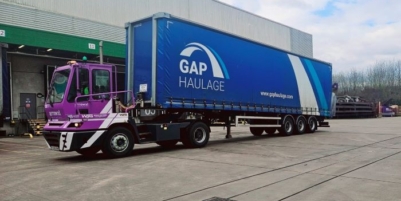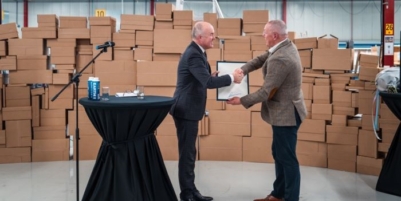-
Nutrivend selects Forterro’s Orderwise to support online expansion and streamline operations - April 11, 2025
-
ARROWXL LAUNCHES AMBITIOUS ZERO WASTE ROADMAP - April 8, 2025
-
THE BCMPA’S NEW CAMPAIGN DRIVES OUTSOURCING SUCCESS IN Q1 - April 7, 2025
-
BLACKOUT TECHNOLOGIES TARGETS TELEMATICS-INTEGRATED MOBILE DEVICE BLOCKING TO COMBAT SMARTPHONE DISTRACTION - April 1, 2025
-
Sparck Technologies awarded Royal designation - March 27, 2025
-
OpenADR Alliance announces first OpenADR 3.0 certified products with EVoke Systems, E.ON Energy and Universal Devices - March 25, 2025
-
Growing fulfilment and contract packer appoints new Managing Director - March 25, 2025
-
When is it time to invest in a WMS? Understanding the key trigger points - March 25, 2025
-
eCapital helps Vantage Recruitment on its journey to financial success - March 24, 2025
-
Hugo Beck Celebrates 70 Years of Packaging Innovation with Open House Events - March 20, 2025
Angelica Neira runs a vegetable stall with her husband in Bogota, Colombia. But lately her customers will have noticed that they have less change in their pocket. That’s because the price of criollas potatoes has doubled to 6,000 pesos ($1.60) per kilo, while tomatoes have doubled in price. Food inflation in Colombia is one of the highest in Latin America, standing at 26.6% for September 2022, according to Statista.
The food inflation crisis that has spread across the world continues to be felt by millions. Grocery inflation in the UK topped 17.5% in March as shoppers’ average annual bills soared by £837, according to Kantar. No product was immune, with everyday household products such as cheese, milk and eggs among the steepest rises. Consequently, three billion people can’t afford to eat healthily, and that number could climb even higher this year.
It’s easy to point the finger for the skyrocketing prices at rising production costs. But the real culprit is the outdated and inefficient trading and distribution methods. For example, despite having greater online connectivity than ever, most essential consumer goods trading is still done offline.
The cost of goods has been driven up significantly by poor supply chain management, fractured relationships across distribution networks, outdated manual processes and reliance on legacy technology across the industry. Recent research from Lloyd’s has found that 25 – 30% of all global food is lost between farms and retail stores.
That’s why the food supply chain and distribution industry needs a complete overhaul. As a result, businesses across the entire network need to take advantage of both the power of technology and the internet to reduce inefficiency and, thus, food prices.
The current crisis isn’t anything new
The current food crisis has been in the offing for a while now. Food prices have been shooting up for more than a decade and have spiked for the third time in 15 years, according to the Food and Agriculture Organization (FAO). Another report from the International Monetary Fund has revealed that food inflation alone has eroded global living standards at the same rate as inflation of all consumption did in the five years before the COVID-19 pandemic.
A prime example of how distribution failures are exacerbating the food crisis is perishable goods in developing countries. In Sub-Saharan Africa, post-harvest losses of fruit and vegetables can be as high as 30%, estimates a World Bank report. That’s due to poor handling, storage and transportation practices. This waste pushes up food prices and severely impacts food security in the region. But it could be easily reduced if the supply chain was better connected, and the products were exchanged on a clear online marketplace.
Additionally, small business growth has been severely restricted by large corporates and established brands such as Amazon as a result of their control of the market and the supply chain. Independent businesses have been in retreat as Amazon continues to grow, with small retailer numbers declining by 65,000 between 2007 and 2017.
Lack of finance and technology
These distribution and supply chain problems are further compounded by the lack of access to finance and technology amongst both farmers and small businesses. According to the World Bank, approximately 70% of all smallholder farmers in developing nations lack access to adequate financial services, limiting their ability to invest and expand their businesses, eliminate food waste and, thus, help mitigate the food crisis.
Technology is the key to improving food product distribution. While there are many viable solutions out there such as smart process automation, remote monitoring, supply chain planning and digital payments, these technologies are inaccessible, unaffordable and unusable by those that need them most. Many also become redundant as soon as they’re launched.
Potential solutions
Collectively, all these problems have created a perfect storm, preventing millions of consumers from accessing the goods they need at affordable prices. And this dire situation will only get worse if nothing is done about it.
There is no silver bullet, but it’s clear food producers and sellers need access to innovative and easy-to-use technology. Open Commerce technology can help; it’s designed to connect buyers and sellers directly so that they can trade fairly and equitably. At RedCloud, we’ve built a platform that is helping more than 300,000 merchants buy essential consumer goods directly from thousands of brands. Our Open Commerce platform has the potential to unlock a new way of trading for the next billion retailers and ensure that essential food products are always available.
Justin Floyd is CEO of open commerce platform, RedCloud Technology
































